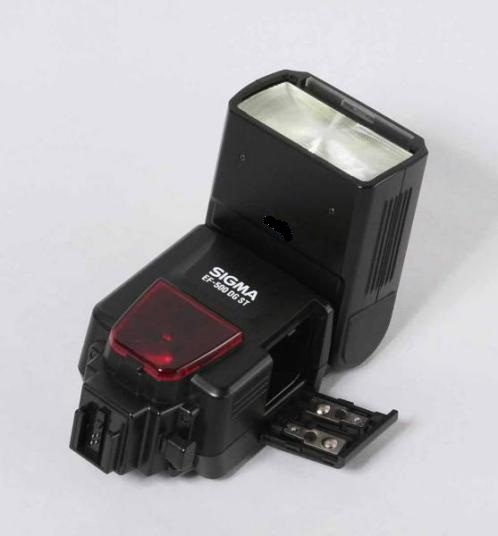이번 삽질도 아트와 관련된 거다.
내가 원래 아트에 관심이 좀...
재활용 쓰레기통에서 망가진 외장 플래시를 구했다.
모델명은 'Sigma EF-500 DG SUPER MA'로 보인다.
확인해 보니 플래시 램프가 타버렸다.
가지고 있는건 펜탁스 카메라인데, 이건 Minolta 마운트용이다.
[Fig. 1] 처럼 생겼다.
I've finished the conversion of the 'Sigma EF-500 DG SUPER MA' Minolta hot shoe mount into the Pentax hot shoe mount. And I'll describe what I've done about it.
My Sigma EF-500 DG SUPER MA's flash lamp was burned out so doing the lamp replacement is initial process and then, I have to modify mechanical-mounting followed by electrical-mounting.
I did not took pictures during the flash lamp replacement.
[Fig. 1 Sigma EF-500 DG Minolta Mount]
펜탁스에 붙여서 사용하려니 3가지 작업을 해야한다.
1. 타버린 램프를 교체
2. 기계적 마운트롤 교체
3. 전기적 마운트도 교체
음.. 일이 많다.
가지고 있던 싸구려 외장 플래시에서 램프를 빼내어 교체작업을 한다.
플래시 분해는 아래 사이트를 참고 했다.
You can refer to below link to disassemble the strobe.
Repairing an erratic Sigma EF500 DG ST
(Thank you weijen)
[Fig. 2 Extracted Burned Flash Lamp]
[Fig. 3 Hot Shoe Mount Replacement]
교체후 타버린 플래시 램프 사진만 찍었다
램프 교체하고 테스트를 해보니 동작은 잘 된다.
기계적 마운트역시 가지고 있던 외장 플래시에서 마운트 부분을 떼어내 붙여 준다.
자, 이제 전기적 마운팅을 해줘야 하는데 자료를 뒤져 보니 이거 만만치가 않다.
그냥 strobe signal을 접지 시키면 될 줄 알았는데 그렇지가 않다.
특히나 Minolta 방식이 까다로운가 보다.
전기적 마운팅을 위해 아래 3개 사이트를 참고 했다.
I've checked it works well after repairing the flash lamp, and have modified the mechanical mount with parts from my cheap external strobe for the Pentax.
Next step is just electrical-mounting but I've been aware of danger of this job. There are no easy way to trigger this strobe manually just like shorting the fire signal to the ground.
I've found out very useful 3 links bellow for this.
adrian : Hacking the Sigma EF-500 DG Super strobe Part 1/2
Kimmo Kulovesi: Sigma EF-500 DG Super PC-sync port modification
Impulsite : Sigma EF-500 DG ST, есть схема
(Thank you adrian, Kimmo Kulovesi and Impulsite)
adrian 링크는 수동으로 플래시를 동작 시키기 위해 겪은 시행착오를 공유해 놓은 내용이고 Kimmo Kulovesi 링크는 adrian의 시행 착오에 15nF 커패시터를 추가하여 개선했다는 내용이다. Impulsite 링크는 플래시 회로도를 공유해 주었다.
3명의 자료 공유 덕분에 내 작업이 비교적 순조롭게 진행 될 수 있었다.
얼굴도 모르는 세계의 3분에게 다시한번 감사드린다. 소중한 시간을 아낄 수 있었다.
I think the adrian is a pioneer of the Sigma EF-500 DG modification. He suggested really good idea for manual trigger through the optical-slave mode of the strobe and this method works well. All images are broken when I visit the adrian's site, but you can search images by image-googling with 'Hacking the Sigma EF-500 DG Super strobe' key words.
Kimmo Kulovesi improved the unstable behavior by attaching 15nF capacitor for bypassing noise, also very nice recommendation.
Impulsite's web is very useful with strobe's schematics.
I could make a conversion into the Pentax mount successfully by these informaion only in 2 days. I hope to say thank you adrian, Kimmo Kulovesi and Impulsite again, you saved my time.
Additionally, I performed several invetigation and experiments to make it clear. When I shorted the photo-diode's anode and cathod, large current was observed by probing the voltage drop with my strobe, so I added current limiting register in my final result, R1 in [Fig. 7].
General Si. photo-diodes let current under 100uA, typically 50~60uA, when detected the light.
The main CPU should observe the delta-voltage, approximatly under a hundred micro-volts to detect the light if there is no signal amplification.
I found that the photo-diode's singal (anode) is routed to the main CPU(?) directly, it's means that the main CPU(?) may detect under 100uV of delta-volts to sync with light signal when it's in optical-slave mode.
The strobe's unstable behavior (without Kimmo Kulovesi's 15nF capacitor) could be explained by this measurement mechanism. If you extended the photo-diodes's signal wire (anode), even small disturbances could influence the delta-micro-volts detection loop so the Kimmo Kulovesi's 15nF capacitor is very important.
To protect DSLR camera I attached the opto-coupler PC817.
You should short pin 5 and 6 to work properly in optical-slave mode. refer to [Fig. 8].
My Pentax camera and the modified Sigma EF-500 DG SUPER MA works perfectly togather in "C0 SL" mode.
요약하자면 다음과 같다.
1. Sigma EF-500 DG SUPER는 단순 단락으로 플래시 동작이 안된다.
2. optical-slave모드에서 내부 photo-diode 신호를 변형해 동작이 가능하다.
3. photo-diode 신호 변형을 위해 wire를 인출 하면 동작이 이상해 진다.
4. 인출된 wire에 커패시터를 부착하면 사용가능한 수준이 된다.
adrian이 말한대로 photo-diode에서 선을 빼내면 수동으로 동작이 가능하지만, 가끔 플래시가 먹통이 된다. 이를 위해 Kimmo Kulovesi는 신호선에 15nF 커패시터를 달아 해결하였다.
Impulsite의 회로도를 참고해 나름 테스트를 해본 결과 photo-diode의 신호를 메인 CPU(?)에서 입력 받는 구조인데, photo-piode의 전류 신호가 수십 uA대로 작다 보니 측정되는 전압의 변화 역시 수십uV 수준이다.
외부에 선을 달아 주게 되면 안테나 역할을 하게 되면서 외부 노이즈가 유입되어 플래시 커패시터의 방전과 충전이 반복되면서 기기가 먹통이 된다.
처음에 adrian이 소개한 대로 photo-diode의 선을 인출 하여 쇼트시켜보니 동작은 하는데 전류가 많이 흐르는듯 하다. 하여, 아래와 같이 카메라도 보호할 겸해서 opto-coupler를 추가로 장착하여 카메라와 연동하는데 성공 했다. [Fig. 7]에서 추가한 R1은 과전류 보호용이고 R2는 opto-coupler의 발광 다이오드 구동용이다.
optical-slave 모드로 동작 시키기 위해서는 [Fig. 8]과 같이 커넥터 5번과 6번을 쇼트 시켜야 한다.
플래시의 발광량 가변이 되니 신세계다.
[Fig. 4 Power board, Pic. from Impulsite]
[Fig. 5 Power board Schematics, Pic. from Impulsite]
[Fig. 6 Photo-Diode Polarity, Anode(A) and Cathod(C)]
[Fig. 7 Modification Schematics]
[Fig. 8 Connector Modification]
Hot shoe connector pin out
- 1 : F2 (READY)
- 2 : F1 (SYNC/FIRE)
- 3 : GND
- 4 : F3 (TTL OK)
- 5/6: Shoe Mount Detection (contacted together when demounted)
- 7/8: LED
[Fig. 9 Wiring]
[Fig. 10 Final Result]
사진은 안찍고 이런거나 만들고 있음.





































